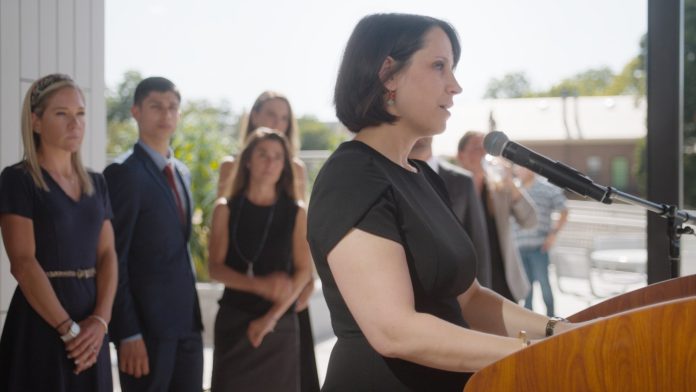A year after the Supreme Court overturned Roe v. Wade, a legion of state legislators across America moved quickly to restrict abortion access. Some targeted medication abortions and mandated counseling for those seeking the procedure. Others proposed outright bans and implemented “bounty hunter” laws, which widened the scope of implication from patient and provider to anyone who helps facilitate access to an abortion. According to a report from the Center for American Progress, 50 of the 563 anti-abortion provisions introduced in 2023 were signed into law that year. Reversing the landmark 1973 case didn’t just strip protections — it set the stage for this dismal state of affairs.
Maisie Crow and Abbie Perrault’s clear-eyed documentary Zurawski v Texas anchors the dire reports of this post-Roe landscape in the experiences of real people. The film, which premiered at Telluride, follows Molly Duane, a senior attorney at the Center for Reproductive Rights, as she counsels a group of plaintiffs suing the Texas government over their restrictive anti-abortion laws. They want attorney general Ken Paxton’s office to define the scope of their ban and acknowledge how its narrowness poses a significant danger to pregnant people.
Zurawski v Texas
The Bottom Line
A clear-eyed and cogent appeal.
Venue: Telluride Film Festival
Directors: Maisie Crow, Abbie Perrault
1 hour 38 minutes
Executive produced by Hillary Clinton, Chelsea Clinton and Jennifer Lawrence, Zurawski v Texas joins a cluster of documentaries surveying the state of abortion rights to sound the alarm. The most recent from this busy landscape includes Sabrine Keane and Kate Dumke’s Preconceived, which premiered at SXSW earlier this year and examines the dangers of anti-abortion legislation through intrepid investigations of duplicitous pregnancy crisis centers. A few years ago, in 2018, Ricki Stern and Annie Sundberg debuted Reversing Roe at Telluride. Their movie took a more analytical approach to the conversation by mapping its historical precarity.
Zurawski v Texas carves out its own distinctive territory by observing the cruel theater of the American courtroom. Crow (who also serves as DP) and Perrault present the stories of four women involved in the case, beginning with Amanda Zurawski, the lead plaintiff. She couldn’t get a termination for her non-viable pregnancy because of Texas’ laws, and it was only after she went into septic shock, on the brink of death, that doctors could intervene to save her life. The experience scarred Zurawski and she suffered permanent damage to her uterus.
Zurawski v Texas opens with galvanizing footage of Zurawski retelling parts of her story to an audience of bored-looking representatives at the U.S. Senate Judiciary Committee on Texas’ abortion pill ruling. She is calm but her words drip with defiance as she reminds lawmakers of their promise to serve and protect those who elected them. Crow and Perrault move swiftly from this footage to scenes that establish how Zurawski and Duane met and decided to work together.
After Zurawski agrees to be the lead plaintiff on the case, Duane gathers the others. Zurawski v Texas is as much about the process of building a lawsuit of this scale and impact as it is about personal testimonies. That the face of this case is a young, upper-middle-class white woman who comes from a generationally Republican family likely broadens its appeal to the state. It also courts audiences who might think the issue of abortion access has nothing to do with them.
In early scenes, Duane spends most of her days taking phone and video calls with other individuals moved to share their experience with restrictive abortion legislation. One particularly harrowing account involves Samantha Casiano, a young Texan who was forced to carry her nonviable pregnancy to term and start a GoFundMe to pay for her dead baby’s funeral. Scenes of Casiano burying her child one day and negotiating the cost of a headstone the next underscore the increased emotional and financial burdens placed on people who live in anti-abortion states.
Her story also testifies to the class and racial layers within debates for reproductive rights. Casiano and her partner Luis couldn’t afford to go to a different state for a termination: Not only would they need to pay for flights and hospital visits, the trip would require taking time off from work and finding suitable childcare options.
Dr. Austin Dennard, the fourth subject and another plaintiff in the Zurawski case, was able to get the abortion she needed in a different state. But as an OB-GYN in Texas, she wrestles with the kind of care she can provide to her own patients. Conversations with her offer the sobering perspective of a medical provider alongside the more emotional one of a patient. With the state’s opaque and grossly punitive laws, Dennard could lose her license and face 99 years in prison if she performs an abortion that violates the law.
Notice the vagueness of that language: an abortion that violates the law. What is the law, and how should the average person interpret it? These are the questions that Duane and her plaintiffs try to get Paxton’s office to answer. The process is often arduous and humiliating. Some of the most stirring scenes in Zurawski v Texas take place in the hushed and hallowed halls of the courtroom, where we watch these women negotiate their right to healthcare (and in many cases, life) in front of lawmakers and judges.
These moments reveal, again, the harsh reality that wends through American life. While a handful of judges, notably all women, identify with the plaintiffs and eventually rule in their favor, the lawmakers, often men, appear inconvenienced by their narratives. The language that representatives of the state use in response to Casiano becoming physically ill during her time on the stand, or Zurawski on the verge of tears as she processes the irrevocable change to her life, is stunning in its passivity and distance.
Crow and Perrault let their subject’s stories speak for themselves. Their film, in its straightforward visual style, functions as an appeal to the subset of Americans who disavow abortion. It is a tool for people like Zurawski’s parents — lifelong Republicans, who, until their daughter almost died, probably considered themselves anti-choice. For the unconvinced, the informative Zurawski v Texas reframes abortion as, above all else, a lifesaving healthcare right.







